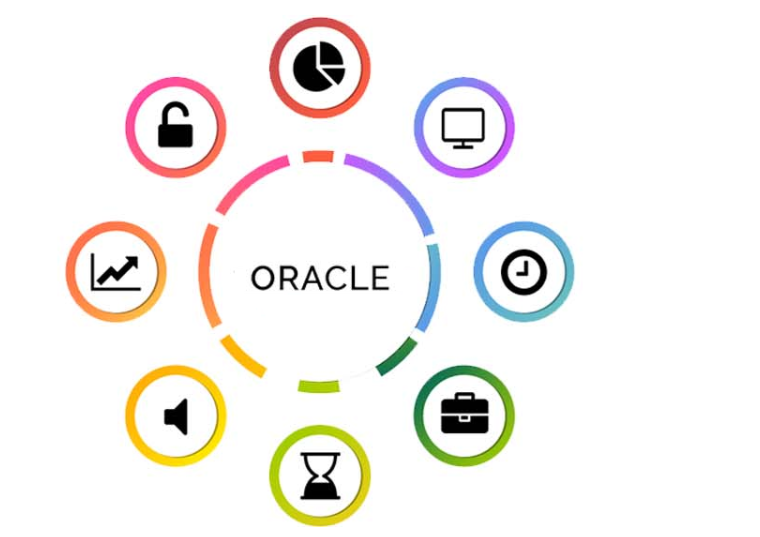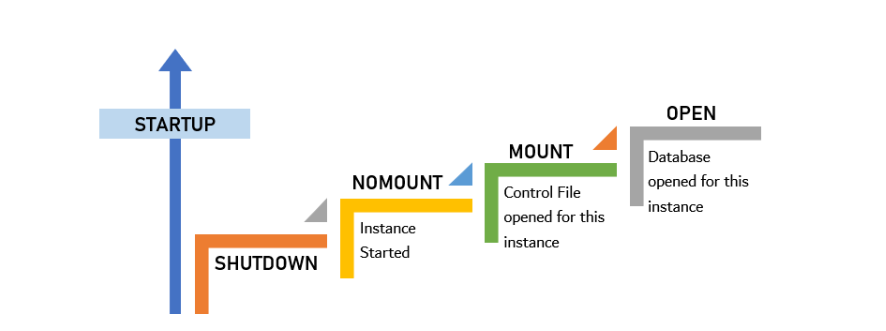WGU D330 OA Study Guide - 2025 | The Magic Behind Oracle Databases 📖
Have you ever wondered how Oracle databases come to life and keep everything running so smoothly? It’s not magic — it’s a well-organized performance involving processes, memory, and a bit of database brilliance. In this article, we’ll explore two key topics essential to Oracle databases:
- Oracle Startup Process: The Oracle startup process involves initializing the database and making it available for use by starting the instance and mounting the database, followed by opening it for user access.
- Parts and Purpose of the SGA: The System Global Area (SGA) is a shared memory structure that stores data and control information for an Oracle instance. It includes components like the buffer cache, shared pool, and redo log buffer, crucial for efficient database operation and performance.
Think of an Oracle database as a high-tech theme park. Before the gates open (for users), there’s a lot of preparation — from starting the rides (processes) to stocking the shops (allocating memory). That’s the startup process: ensuring all systems are ready before the action begins.
Once open, the SGA is like the multitasking manager, keeping everything running smoothly. From speeding up queries to ensuring data integrity, it’s the unsung hero of database efficiency. By mastering these topics, not only will you excel in the WGU D330 module, but you’ll also appreciate the genius behind Oracle databases.
Let’s dive in and uncover the secrets of the Oracle startup process and the SGA’s inner workings!
How to Use This Guide for the WGU D330 OA Exam?📖
The D330 Data Systems Administration OA exam at WGU evaluates your understanding of database administration processes, Oracle database management, and system configuration. This guide simplifies the key concepts of the Oracle startup process and the parts and purpose of the SGA to help you grasp the topics tested in the exam.
We also provide exam-style questions and practical applications to ensure you’re fully prepared for the questions on the WGU D330 OA exam

Understanding the Oracle Startup Process📝
When we think of Oracle databases, it’s like imagining the inner workings of a large library. Just as a librarian must prepare everything before allowing visitors to borrow books, the Oracle database goes through a series of steps to become ready for use. Let’s take a journey through these steps to understand the Oracle startup process step by step.
What is the Oracle Startup Process?
The Oracle startup process is the sequence of steps the database follows to prepare itself to handle user requests effectively. It involves allocating memory for operations, loading vital files to organize data, and activating background processes to perform critical tasks such as writing data and monitoring user sessions.
To simplify this, think of the Oracle database as a sophisticated machine that needs to warm up before use. Each stage of this process is like setting up a performance system: starting the engines, checking components, and then making it ready for the user.
Key actions during the startup process include:
- Reading the initialization parameter file (a configuration file that acts like a set of instructions for the database setup).
- Establishing memory areas (System Global Area and Program Global Area) to store data and operational information.
- Activating background processes that manage the database’s internal functioning, such as recovery and data writing.
The startup process ensures that all necessary components are in place and functioning, paving the way for reliable database operation. Understanding these steps is fundamental for anyone managing Oracle databases, particularly for tackling real-world challenges like troubleshooting and optimizing performance.
Steps in the Oracle Startup Process
The Oracle startup process involves a carefully organized sequence of steps that prepare the database for user interactions. Each step plays a critical role in ensuring the database’s stability and functionality. Here is a thorough breakdown of these steps:

1. Initialization Phase
- The process begins by loading an essential configuration file known as the initialization parameter file (init.ora or spfile). This file contains the rules and settings that govern how the database should allocate resources, handle processes, and manage memory.
- Key settings include:
- Memory allocations for the System Global Area (SGA) and Program Global Area (PGA).
- The number of background processes to initiate.
- File locations and database-specific configurations.
Importance: This phase acts as the blueprint, defining the operating environment for the database. Without it, the system would lack direction and fail to start.
2. Nomount Phase
- During this phase, the Oracle instance is started. The instance consists of:
- Memory Structures: The SGA and PGA are initialized to provide the necessary workspace for operations.
- Background Processes: Critical processes such as DBWR (Database Writer) and LGWR (Log Writer) are initiated to handle database operations efficiently.
- However, the database itself is not yet attached, meaning no data files are accessed at this stage.
Analogy: Imagine starting the engine of a car. The systems are powered up, but you’re not ready to drive yet. Similarly, this phase ensures the internal components of the database are active but not yet connected to the actual data.
3. Mount Phase
- In the mount phase, the database connects to the control files. These files act as a roadmap, providing crucial information about the database’s physical structure, including the location of data files and redo log files.
- Oracle verifies the availability and integrity of these files during this phase.
Importance: This step ensures the database is aware of its components and that they are in working order. It’s like preparing a car’s navigation system before a trip.
4. Open Phase
- In the final step, the database is opened for users. Key actions include:
- Accessing data files, which store the actual data.
- Preparing redo log files for recording changes and ensuring data recovery.
- Once open, the database is fully operational, allowing users to read, write, and interact with the stored data.
Analogy: This is akin to shifting a car into drive and hitting the road. All components are active and working together to provide a smooth experience.
Each of these phases builds on the previous one, ensuring the database transitions from a dormant state to a fully functional system in a controlled and reliable manner.
Key Background Processes
During the startup process, Oracle activates several background processes, each with a distinct role in ensuring the database runs smoothly and efficiently. These processes work behind the scenes, just like stagehands ensuring a theater production goes off without a hitch. Here is a detailed look at the key background processes:
- DBWR (Database Writer):
- The DBWR process is responsible for writing data from the memory (specifically the database buffer cache) to the data files on disk.
- Why is this important? Think of DBWR as a scribe copying notes from a chalkboard onto permanent paper. This ensures that changes made in memory are saved securely on disk for long-term storage.
- The DBWR process is responsible for writing data from the memory (specifically the database buffer cache) to the data files on disk.
- LGWR (Log Writer):
- LGWR writes the redo log buffer’s contents to the redo log files. Redo logs are essential for maintaining data integrity and enabling recovery in case of failures.
- How it works: Every time a transaction is committed (e.g., saving changes made to data), LGWR ensures these changes are recorded in the redo log files before the user gets confirmation. This guarantees that data is never lost, even during unexpected shutdowns.
- LGWR writes the redo log buffer’s contents to the redo log files. Redo logs are essential for maintaining data integrity and enabling recovery in case of failures.
- PMON (Process Monitor):
- PMON’s role is to clean up after failed user or system processes. For instance, if a user’s session crashes, PMON releases any resources like locks or memory that were being used by that session.
- Analogy: PMON acts like a diligent custodian, cleaning up leftovers from incomplete tasks to ensure the system remains clutter-free.
- PMON’s role is to clean up after failed user or system processes. For instance, if a user’s session crashes, PMON releases any resources like locks or memory that were being used by that session.
- SMON (System Monitor):
- SMON handles recovery tasks, particularly after the database is started following an unexpected shutdown. It ensures that the database is consistent by rolling forward changes from redo logs and rolling back incomplete transactions.
- Importance: This process is vital for maintaining the integrity of the database. If there are inconsistencies or incomplete operations, SMON ensures everything is resolved before the database becomes operational.
- SMON handles recovery tasks, particularly after the database is started following an unexpected shutdown. It ensures that the database is consistent by rolling forward changes from redo logs and rolling back incomplete transactions.
Together, these background processes create a harmonious system that handles data storage, recovery, and maintenance seamlessly. Understanding their roles helps database administrators troubleshoot issues and optimize performance effectively.
Commands Used in the Startup Process
To perform the startup process, database administrators use commands in a tool called SQL*Plus. Here are the key ones:
- STARTUP NOMOUNT:
- Starts the Oracle instance without attaching to the database files.
- Starts the Oracle instance without attaching to the database files.
- ALTER DATABASE MOUNT:
- Mounts the database by reading the control files.
- Mounts the database by reading the control files.
- ALTER DATABASE OPEN:
- Opens the database, making it accessible to users.
Each of these commands corresponds to one of the steps we discussed earlier, ensuring the database is brought online in a controlled manner.
Memory Structures in the Startup Process
A critical part of the startup process is allocating memory. The two main memory structures are:
- System Global Area (SGA):
- This is a shared memory area used by all processes. It includes:
- Database Buffer Cache: Temporarily holds data blocks read from disk.
- Shared Pool: Stores frequently used SQL statements to speed up processing.
- Redo Log Buffer: Holds information about changes made to the database.
- This is a shared memory area used by all processes. It includes:
- Program Global Area (PGA):
- This is private memory for individual processes, storing information like sort operations and session data.
Proper memory allocation ensures the database can handle multiple users efficiently without slowing down.
Common Errors During Startup
Sometimes, things don’t go as planned. Here are some common issues:
- ORA-01078: This error occurs when the initialization parameter file has incorrect settings.
- Missing Control Files: If the control file is unavailable or corrupted, the database can’t proceed.
- Data File Errors: If data files are missing or damaged, the database won’t open.
Troubleshooting Tip: Always check the error messages carefully. They provide clues about what went wrong and how to fix it.
Importance For D330 OA
Understanding the Oracle startup process is like learning the steps to set up a complex but powerful machine. By following these phases carefully and knowing the commands and components involved, you can ensure your Oracle database operates smoothly. This knowledge is not only vital for managing databases but also for tackling practical scenarios you might encounter in your career. With this foundation, you’re well on your way to mastering database administration in the WGU D330 module.
Understanding the Parts and Purpose of the System Global Area (SGA) For D330 OA 📝
When working with an Oracle Database, the System Global Area (SGA) is like the central nervous system, coordinating and facilitating all the activities of the database. It plays a critical role in ensuring the efficient and reliable operation of the database. Let’s break down the SGA into its parts and understand their purposes step by step.
What is the System Global Area (SGA)?
The SGA is a shared memory region allocated when an Oracle instance starts. It contains data and control information that multiple users and processes need to interact with the database.
Why is it important? Imagine a library where many people are reading the same book. Instead of giving each person their own copy, the library provides a shared reading area where everyone can access the same materials. The SGA works in a similar way, allowing efficient data sharing and reducing redundancy.
Key Components of the SGA
The SGA is divided into several components, each serving a specific purpose to optimize the performance and functionality of the database. Here are the main parts:
- Database Buffer Cache
- Purpose: This cache stores copies of data blocks read from database files. When users request data, Oracle checks this cache first to see if the data is already available.
- Functionality: By reducing the need to fetch data from disk repeatedly, the database buffer cache improves performance significantly.
- Analogy: Think of it as a frequently accessed shelf in the library, saving time by keeping popular books within easy reach.
- Purpose: This cache stores copies of data blocks read from database files. When users request data, Oracle checks this cache first to see if the data is already available.
- Shared Pool
- Purpose: This is a shared memory area for SQL statements, PL/SQL code, and metadata about database objects.
- Key Components:
- Library Cache: Stores parsed SQL statements and execution plans, speeding up the execution of repeated queries.
- Data Dictionary Cache: Contains metadata about tables, indexes, and other database objects, making it quicker to access this information.
- Importance: The shared pool minimizes the overhead of parsing SQL statements repeatedly, boosting query execution speed.
- Purpose: This is a shared memory area for SQL statements, PL/SQL code, and metadata about database objects.
- Redo Log Buffer
- Purpose: Temporarily stores redo entries, which are records of changes made to the database. These entries are eventually written to redo log files.
- Functionality: The redo log buffer ensures data integrity by tracking all changes, enabling recovery in case of failures.
- Example: Imagine a logbook where the librarian notes every change made to a library’s collection. This ensures that all updates can be reviewed and restored if needed.
- Purpose: Temporarily stores redo entries, which are records of changes made to the database. These entries are eventually written to redo log files.
- Large Pool
- Purpose: Provides memory for large operations, such as backup and restore activities, and session memory for Oracle Streams.
- Benefits: Reduces contention in the shared pool by handling large memory requests separately.
- Analogy: Think of it as a private reading room for special projects, freeing up the main reading area for other users.
- Purpose: Provides memory for large operations, such as backup and restore activities, and session memory for Oracle Streams.
- Java Pool
- Purpose: Allocates memory for executing Java code within the database. This is particularly important for applications that use Java stored procedures or Java-based features.
- Usage: Ensures smooth execution of Java programs without affecting other SGA components.
- Purpose: Allocates memory for executing Java code within the database. This is particularly important for applications that use Java stored procedures or Java-based features.
- Streams Pool
- Purpose: Supports Oracle Streams, which allow for data replication and messaging within the database environment.
- Functionality: Manages memory for capturing and applying changes to data across different systems.
- Significance: Facilitates data synchronization and consistency in distributed systems.
- Purpose: Supports Oracle Streams, which allow for data replication and messaging within the database environment.
Purpose of the SGA
The SGA is designed to optimize database performance and ensure smooth multi-user operations. Here are its primary purposes:
- Performance Optimization
- By caching frequently accessed data in memory, the SGA minimizes time-consuming disk I/O operations, leading to faster query performance.
- By caching frequently accessed data in memory, the SGA minimizes time-consuming disk I/O operations, leading to faster query performance.
- Resource Sharing
- The SGA allows multiple users to access shared resources simultaneously without conflicts. This enhances concurrency and ensures efficient database operation.
- The SGA allows multiple users to access shared resources simultaneously without conflicts. This enhances concurrency and ensures efficient database operation.
- Data Integrity and Recovery
- The redo log buffer plays a critical role in maintaining data integrity by logging changes before they are written to disk. This allows the database to recover quickly from failures.
- The redo log buffer plays a critical role in maintaining data integrity by logging changes before they are written to disk. This allows the database to recover quickly from failures.
- Memory Allocation Management
- The SGA dynamically adjusts memory allocation for its components based on workload requirements, ensuring optimal resource utilization.
Monitoring and Managing the SGA
- Dynamic SGA Management
- Oracle can resize components of the SGA dynamically to meet changing workload demands. This eliminates the need for manual adjustments and ensures optimal performance under varying conditions.
- Oracle can resize components of the SGA dynamically to meet changing workload demands. This eliminates the need for manual adjustments and ensures optimal performance under varying conditions.
- Monitoring Tools
- Tools like Oracle Enterprise Manager and SQL queries can be used to monitor the SGA’s performance. These tools provide insights into memory usage, identifying potential bottlenecks and areas for improvement.
Importance For D330 OA
The System Global Area (SGA) is the backbone of Oracle’s memory management, ensuring efficient data access, resource sharing, and performance optimization. By understanding its components and their purposes, students can appreciate how the SGA supports the complex operations of an Oracle Database. This knowledge is crucial for effective database administration and mastering concepts in the WGU D330 module.
Tired of reading blog articles?
Let’s Watch Our Free WGU D330 Practice Questions Video Below!

Wrapping Up: Mastering Oracle’s Core Concepts for Success (WGU D330 OA) 📖
As we’ve explored, the Oracle startup process and the System Global Area (SGA) are the cornerstones of Oracle Database management. From the precise steps needed to bring the database online to the intricate memory structures that keep it running efficiently, these topics form the foundation of understanding Oracle databases.
Grasping these concepts isn’t just about passing the module — it’s about building confidence in handling real-world database challenges. The Oracle startup process ensures everything is prepared to run smoothly, while the SGA optimizes performance and supports multi-user environments seamlessly.
Remember, these topics will likely feature in the final Objective Assessment (WGU D330 OA). Take the time to review, practice, and solidify your understanding. Your dedication now will pay off not just in exams but in your future as a database administrator.
Good luck, and may your journey through Oracle databases be as smooth as a well-tuned query! Keep striving, and stay curious, and you’ll achieve great success in the WGU D330 module and beyond.






